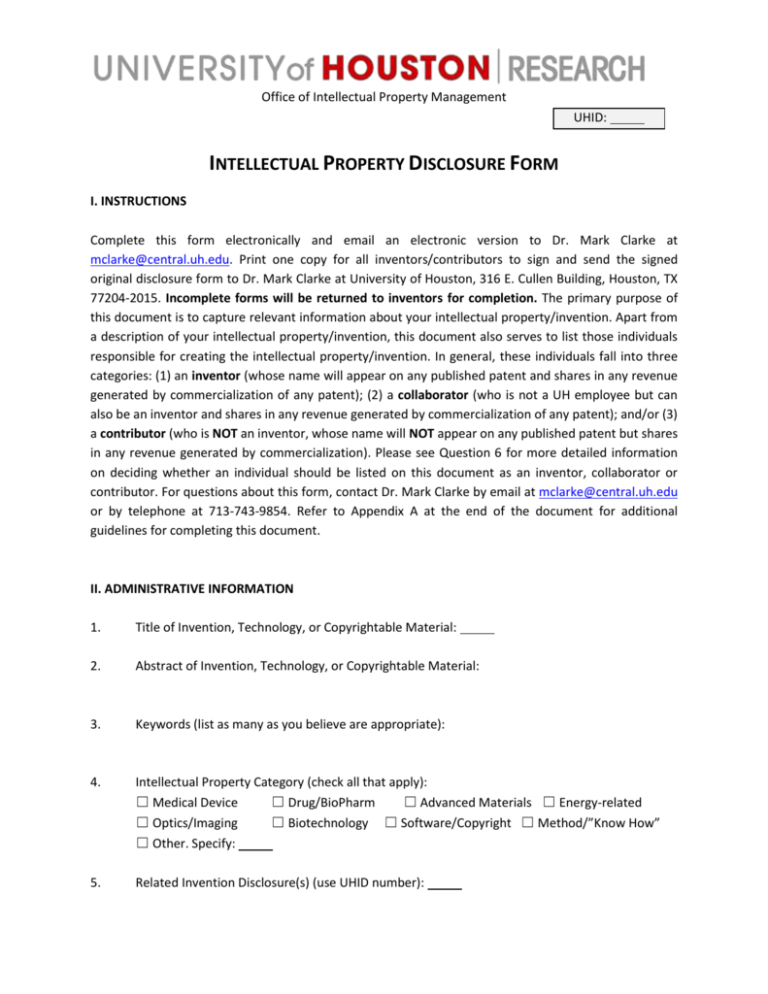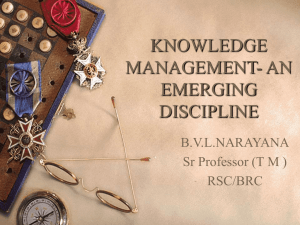DOR.OIPM.01 Disclosure Form
advertisement

Office of Intellectual Property Management UHID: INTELLECTUAL PROPERTY DISCLOSURE FORM I. INSTRUCTIONS Complete this form electronically and email an electronic version to Dr. Mark Clarke at mclarke@central.uh.edu. Print one copy for all inventors/contributors to sign and send the signed original disclosure form to Dr. Mark Clarke at University of Houston, 316 E. Cullen Building, Houston, TX 77204-2015. Incomplete forms will be returned to inventors for completion. The primary purpose of this document is to capture relevant information about your intellectual property/invention. Apart from a description of your intellectual property/invention, this document also serves to list those individuals responsible for creating the intellectual property/invention. In general, these individuals fall into three categories: (1) an inventor (whose name will appear on any published patent and shares in any revenue generated by commercialization of any patent); (2) a collaborator (who is not a UH employee but can also be an inventor and shares in any revenue generated by commercialization of any patent); and/or (3) a contributor (who is NOT an inventor, whose name will NOT appear on any published patent but shares in any revenue generated by commercialization). Please see Question 6 for more detailed information on deciding whether an individual should be listed on this document as an inventor, collaborator or contributor. For questions about this form, contact Dr. Mark Clarke by email at mclarke@central.uh.edu or by telephone at 713-743-9854. Refer to Appendix A at the end of the document for additional guidelines for completing this document. II. ADMINISTRATIVE INFORMATION 1. Title of Invention, Technology, or Copyrightable Material: 2. Abstract of Invention, Technology, or Copyrightable Material: 3. Keywords (list as many as you believe are appropriate): 4. Intellectual Property Category (check all that apply): ☐ Medical Device ☐ Drug/BioPharm ☐ Advanced Materials ☐ Energy-related ☐ Optics/Imaging ☐ Biotechnology ☐ Software/Copyright ☐ Method/”Know How” ☐ Other. Specify: 5. Related Invention Disclosure(s) (use UHID number): 6. Please answer the following questions about your intellectual property/invention: (i) What is your intellectual property/invention? (ii) What about your intellectual property/invention is new and/or better than existing approaches/technologies? 7. Full name, including salutation, and title(s) of inventor(s), contributor(s) and collaborator(s) as well as a description of the relative contribution of each to support the identified percentage. If necessary, append additional pages. Note on Inventorship: To be an "inventor" that person must have contributed to the CONCEPTION of one of the claims in a patent application. Conception occurs when all that remains to be accomplished in order to perfect the intellectual property is construction. It is "the formation in the mind of the inventor of a definite and permanent idea of the complete and operative invention." The inventor is not required to have reduced the invention to practice. A “collaborator” is a person who is outside of the UH System and who has been, is, or will be a contributor, inventor or joint inventor (as those terms are defined in this Form) on the disclosed intellectual property. A “contributor” is a person who is deemed by the inventors to share in future revenues based on his/her percentage contribution but is not an “inventor” and will not be listed as such on any patent. To be joint inventors, there must be some sort of communication or collaboration between the persons involved. However, it is not necessary that the joint inventors have equal contributions, invent at the same time, or invent all the intellectual property of every claim of the disclosure jointly. Accordingly, if the joint inventors invented different parts of the intellectual property, good records should be kept so that the named inventors can be changed should one inventor’s contributions be dropped from the patent application’s claims. *The Office of Intellectual Property Management should be notified if an inventor, joint inventor or contributor leaves UH. Individual 1. Primary Investigator (PI for purposes of the disclosure only). Is PI also an inventor? ☐ Yes ☐ No Name Title Percentage College: Department and/or Center: Campus: DOR.OIPM.01 - Disclosure Form Form updated March 2013 2 of 10 Description of the relative contribution: University Address Home Address Employee ID #: Permanent Address (if different to Home Address Citizenship: ☐ U.S.A. ☐ Perm. Res. (If other, specify: ) Email: ☐ Other Telephone: Fax: Other: a) Percent time employed at UH: b) Other Employment/Appointments, if any: c) Have you signed an agreement with a third party which relates to the invention? ☐ Yes ☐ No d) If yes, ATTACH A COPY. Individual 2. ☐ Inventor or ☐ Contributor or ☐ Collaborator Name Title Percentage College: Campus: Department and/or Center: Description of the relative contribution: University Address Home Address Employee ID #: Permanent Address (if different to Home Address Citizenship: ☐ U.S.A. ☐ Perm. Res. (If other, specify: ) Email: ☐ Other Telephone: Fax: Other: a) Percent time employed at UH: b) Other Employment/Appointments, if any: c) If a Collaborator, is an Inter Institutional Agreement or collaboration agreement in place between the Collaborator and UH? ☐ Yes ☐ No d) If yes, ATTACH A COPY. Individual 3. ☐ Inventor or ☐ Contributor or ☐ Collaborator Name Title Percentage College: Campus: Department and/or Center: Description of the relative contribution: DOR.OIPM.01 - Disclosure Form Form updated March 2013 3 of 10 University Address Employee ID #: Home Address Permanent Address (if different to Home Address Citizenship: ☐ U.S.A. ☐ Perm. Res. (If other, specify: ) Email: ☐ Other Telephone: Fax: Other: a) Percent time employed at UH: b) Other Employment/Appointments, if any: c) If a Collaborator, is an Inter Institutional Agreement or collaboration agreement in place between the Collaborator and UH? ☐ Yes ☐ No d) If yes, ATTACH A COPY. Individual 4. ☐ Inventor or ☐ Contributor or ☐ Collaborator Name Title Percentage College: Campus: Department and/or Center: Description of the relative contribution: University Address Home Address Employee ID #: Permanent Address (if different to Home Address Citizenship: ☐ U.S.A. ☐ Perm. Res. (If other, specify: ) Email: ☐ Other Telephone: Fax: Other: a) Percent time employed at UH: b) Other Employment/Appointments, if any: c) If a Collaborator, is an Inter Institutional Agreement or collaboration agreement in place between the Collaborator and UH? ☐ Yes ☐ No d) If yes, ATTACH A COPY. Note: If more than four individuals will appear on this document please “cut and paste” additional inventor information boxes into the document immediately above. Number the additional boxes sequentially beginning with Individual 5, etc. 8. Location(s) and dates where (1) the idea was conceived, (2) where the research related to the invention was performed, and (3) where the invention was actually reduced to practice: DOR.OIPM.01 - Disclosure Form Form updated March 2013 4 of 10 Date Location Idea conception Research performed Reduction to practice (may not apply) (a) Date the first drawing or sketch was made: (b) Date first construction or model was made: (c) Date conception was first documented: “Conception” occurs when the inventor or inventors has formulated the complete invention in his or her mind, with no more remaining than the construction of the invention without much experimentation or guessing. In the United States, “actual reduction to practice” is said to occur when: the intellectual property is constructed and shown to be operating. 9. Location of the relevant notebooks containing information pertaining to this intellectual property and a list of the relevant page numbers. Notebooks are preferably signed and witnessed. 10. List of sponsor(s) of the intellectual property and the relative contribution (percentage) of each sponsor. This includes both private and public funding or grants. Call your OCG grant administrator if unsure. Sponsor Percentage Acct. no. Has the intellectual property been reported to the Sponsor? ☐ Yes ☐ No Briefly describe the purpose of the grant or contract and how development of the intellectual property was aided: 11. Any prior specific or general disclosures of the intellectual property, oral presentations, publications, negotiations, disclosures to sponsors, disclosures to colleagues at other schools, etc. Provide location, date, and citation and attach copies of meeting abstracts, presentation slides, or publications/publication drafts. DOR.OIPM.01 - Disclosure Form Form updated March 2013 5 of 10 12. Is any publication or disclosure of the intellectual property planned or scheduled within the next six months? Attach draft of manuscript, if available. Include publication/presentation date of any poster, research paper, etc. ☐ Yes ☐ No If yes, describe: 13. Has the intellectual property been disclosed to industrial representatives? Has any commercial interest been shown in the intellectual property? If so, list companies, specific individuals, and their titles. 14. List other companies that might be contacted for interest in the intellectual property and potential licensees or manufacturers and other companies active in this area. Especially important are contacts you may have inside a company. Include e-mail addresses where known. 15. What is the potential market for the intellectual property? Outline your views for potential commercial applications. 16. Have you built a prototype model/device, created a simulation, or designed software to test whether your invention works?☐ Yes ☐ No If yes, give dates and details of tests. 17. List known inventions, patents, or publications by other research workers related to or similar to this one. Inventors are encouraged to conduct preliminary patent searches. The following is a website that may be used for patent searching. Submit your findings in the space provided below or attach a separate page to this Disclosure. Google Patents http://www.google.com/patents Enter Patent Search Findings Here 19. List independent referees with expertise in the area of the intellectual property with whom we may communicate with for additional information. No communication will be made without your approval. These can be individuals within and outside the university. DOR.OIPM.01 - Disclosure Form Form updated March 2013 6 of 10 20. Discuss the twelve (12) month work plan for this intellectual property. 21. OTHER. (a) Did the research leading to the intellectual property utilize biological material obtained from an outside source? ☐ Yes ☐ No If yes, what is the source? (b) Was a material transfer agreement in place between the outside source and UH? ☐ Yes ☐ No If yes, name of institution/company: Date of Agreement: . ATTACH COPY. III. The Non-Proprietary Description An ideal non-proprietary description has one simple objective – to generate interest from potential licensees without revealing how the innovation is accomplished. It communicates the intellectual property’s benefits and advantages but provides no information which would enable the reader to achieve them. An effective non-proprietary description walks a fine line between revealing too little to be of interest and telling them so much that the intellectual property is no longer proprietary. Here are sample questions you might answer in the description: What is the function of the intellectual property? For example, will it improve or make possible a process or product? Summarize the purpose. How will the intellectual property benefit the licensee? Will it reduce costs, increase efficiency, or improve accuracy? Summarize the use of the intellectual property. Why is the intellectual property an improvement over what exists now? That is, why is it better than competing products, methods, processes, or applications? Advantages of this intellectual property over current practice. What is the intellectual property’s working status? For example, is there a working prototype? Has clinical testing started? State of development of the intellectual property. Whenever possible, try to avoid technical language, i.e. use layman’s language – decision makers in industry are not always experts in your field, and in some cases, have no technical background at all. Attach the Non-Proprietary Summary to the Disclosure. Title: DOR.OIPM.01 - Disclosure Form Form updated March 2013 7 of 10 Description IV. THE DISCLOSURE It is important that you provide the most comprehensive and complete disclosure possible as the disclosure may be used as legal verification of the intellectual property. Furthermore, a complete disclosure will allow the Office of Intellectual Property Management to make an adequately informed recommendation with regard to whether the university will proceed with protection or marketing of the intellectual property. If there are deficiencies in the disclosure, further information from the inventor must be requested and thus slow processing time. 1. Append a full description of the intellectual property. Information that should be included in a full description includes: (a) Drawings illustrating the intellectual property or flow diagrams (required for software); (b) Chemical structural forms; (c) List of equivalents which can be substituted for the intellectual property or for the components of the intellectual property; (d) Reprints of articles or patents describing the device, products, process or methods similar to the one described in the disclosure; (e) A specific section describing the novel aspects or unique features of the device, products, process, or methods explaining how the intellectual property differs from the present technology, the non-obviousness of the intellectual property, what problems does it solve and what advantages does it possess; (f) The possible uses for the intellectual property, in addition to immediate applications and uses that might be realized in the future; (g) The current status of the intellectual property, what tests have been done and describe all available experimental data; (h) If software, include the first and last 100 lines of code and include a disk/CD of the software in compiled and non-compiled forms (software should also include instructions for operating and installing the software); (i) A list of potential claims of the intellectual property. V. ADDITIONAL INFORMATION 1. Have all required approvals been secured for the work on this intellectual property (human subjects, recombinant DNA, radiation safety, animal care, etc.)? ☐ Yes ☐ No 2. Signatures. By my signature below I assert that I am the inventor or contributor of this intellectual property, have read this disclosure and feel it is a complete and adequate disclosure DOR.OIPM.01 - Disclosure Form Form updated March 2013 8 of 10 of the intellectual property, and agree to be bound by the University of Houston’s policy on Intellectual Property (including without limitation with regard to University research) and to sign appropriate documents to acknowledge and secure the University of Houston’s ownership of the intellectual property. To the extent this intellectual property is the result of University research that I am engaged in under the University of Houston’s policy on Intellectual Property, I hereby assign all of my right, title, and interest to the intellectual property described herein, including worldwide rights therein, to the University of Houston, and I acknowledge that the compensation or other benefits that I received from the University of Houston are valuable and sufficient consideration for this assignment. The percentage allocated to me on this disclosure is correct. 3. If you are a staff member, graduate student, or postdoctoral fellow, has the principal investigator in your lab been informed of this intellectual property disclosure? ☐ Yes ☐ No INVENTOR/CONTRIBUTOR SIGNATURE: Processing of this intellectual property disclosure by OIPM cannot commence until all inventors sign and date this intellectual property disclosure in the spaces below. Name Signature Date Name Signature Date Name Signature Date Name Signature Date Mark S. Clarke, Ph.D. Signature Associate VC/VP, Technology Transfer Date Received by the University of Houston: DOR.OIPM.01 - Disclosure Form Form updated March 2013 9 of 10 APPENDIX A Additional guidelines Timeline for Inventors Submit a complete disclosure in a timely fashion: at least 3 months prior to a public disclosure (thesis publication, journal paper article, posters, textbook, etc.) If you have already made a public disclosure, we have 1 year from the date of disclosure to protect the invention in US. Foreign rights are generally lost permanently after such a public disclosure. Inventors shall present their technology to the Intellectual Property Committee for review and feedback before Non-Provisional patent application. The IPC meets every month to review new inventions during the fall and the spring semesters. Base your presentation to the IPC on the following items: Prior Art Search www.uspto.gov: Review the current patent landscape in your invention Define the novel attributes of the invention compared to current standards and/or products Identify the patentable elements not covered in the existing patent landscape Commercial Potential Identify the commercial needs and niche of your invention Identify other applications for your invention Identify existing competition Identify commercial partners Commitment Note that patent prosecution demands substantial time from the inventor (you), to respond to office actions, work with attorneys, and present data as required to defend the patent. Consider such factors when making invention disclosures. Mark your calendar – Make yourself available to present your invention before the IP Committee. Commercialization efforts would require additional time from the inventors. DOR.OIPM.01 - Disclosure Form Form updated March 2013 10 of 10







